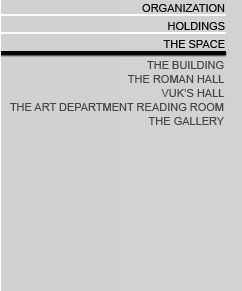
|

During the renovation of the building of the Belgrade City Library from 1983 to 1986, the remains of an older building were discovered while lowering the level of the basement floor. Archaeologists established that these had been the foundations of a rampart and a tower above the main gate of the Roman fortress located in the Upper Town of the Belgrade fortress. This important discovery had its impact on the plan of the design. Therefore, instead of a book storeroom, the Library obtained its Roman Hall, which is intended for public events.
Due to its commanding view of the border between the powerful Roman Empire and barbaric lands outside, it is well known that the position above the confluence of the Sava and the Danube located at the end of the Belgrade fortress was chosen for the construction of a military camp. At the beginning of the second century, legia IV Flavia was the permanent garrison in the camp, and stayed there until the end of the 4th century or the beginning of the 5th century. The fortified military camp – castrum, in this case – was constructed from stone, which was obtained from a quarry, had a trapezoid base and a total area of around 20 hectares. Constructed according to the rules of Roman military architecture, the camp was one of the biggest facilities of the kind in this part of the border region. All of its gates were protected by two square towers. The southeast rampart, where the main street started and which had the main south camp gate (porta decumana) stretched between Tadeuša Košćuška and Pariska streets, leading to the north gate. One of the towers from this gate was found under the sculpture of Milan Rakic at the end of Knez Mihailova Street. The remains of the other, east tower are located in the Roman Hall. Apart from this tower, the brick-covered canal with a massive lead pipe that passes through the foundations of the rampart may also be seen here. This was a part of the water supply system used for supplying the castrum.
From the standpoint of protection of cultural heritage, the manner in which the archaeological site in the Roman Hall has been protected presents the most successful solution for permanent preservation without over-conservation, as well as a presentation of Belgrade’s archeological heritage fitted into the modern architecture of the city.
The Roman Hall is a unique space with an archaeological site in situ and a collection of stone fragments comprising sculptures, altars, Roman tombstones (stellas) and other stone art originating from the territory of Singidunum and the Danube-region of the province of Upper Mesia, created in the period between the 2nd and 4th century. The antique ambiance of the Roman Hall is a representative gathering point, where our citizens may attend numerous cultural programs that take place every day.
|



